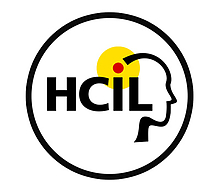Annual HCIL Symposium Features Wearable Technology, Data Visualization and More

From wearable technology that teaches kids about human anatomy to digital tools that let medical professionals quickly visualize electronic health records, the annual Human-Computer Interaction Lab (HCIL) Symposium at the University of Maryland will highlight the latest in research, innovation and education that is best defined by how people interact with new technologies.
The May 28 event, now in its 32nd year, will be held in the Computer Science Instructional Center on the UMD campus. It will feature presentations, tutorials and workshops led by HCIL faculty and students.
The College of Information Studies (iSchool), the university’s Institute for Advanced Computer Studies (UMIACS), and the College of Computer, Mathematical, and Natural Sciences are major sponsors of the symposium. The symposium also attracts external funding from dozens of industry partners.
For attendees wanting to learn about the latest visualization tools related to health care, a workshop on EventFlow will showcase a unique application that helps users explore and analyze patterns-of-point and interval-based events from patient history records and other information sources.
Developed by Distinguished University Professor of Computer Science Ben Shneiderman and HCIL Associate Director of Research Catherine Plaisant, EventFlow offers a novel solution for displaying events, simplifying their visual impact, and making meaningful queries.
“We’ve made great strides in the past year to improve EventFlow to meet the diverse needs that emerged from 18 case studies,” says Shneiderman, who was the founding director of HCIL from 1983 to 2000.
Studying event sequences has been very difficult until now, Shneiderman adds, but EventFlow has opened up vast possibilities for research in medical histories, cybersecurity, e-commerce customer histories, and social media logs.
The EventFlow workshop will also feature experts from the University of British Columbia, Walter Reed Army Medical Center, Leidos, and the University of Maryland, Baltimore.
“We’re excited to be working with large corporations and others in developing advanced tools and helping medical researchers,” Shneiderman says. “Each year, the number of EventFlow users grows as people discover the new powers that event sequence analysis offers.”
In one of the symposium’s plenary talks, Jon Froehlich, an assistant professor of computer science, will discuss a series of wearable visualizations that include a “smart” jersey called Social Fabric Fitness for visualizing live fitness data, and a shirt called BodyVis aimed at helping children learn about their bodies and healthy living.
With BodyVis, students can discover their own anatomy through sensors and interactive displays that are attached to the clothing they wear, Froehlich says. For example, a life-sized pair of lungs on a shirt would light up to show how air flows in and out of a child’s lungs in tandem with their breathing.
Froehlich is the principal investigator on the project. He is working with Tamara Clegg, an assistant professor in the College of Education and the iSchool, Leyla Norooz, a first-year doctoral student in the iSchool, and Seokbin Kang, a first-year doctoral student in computer science. Multiple undergraduate students have also contributed to the design and evaluation of BodyVis.
In another plenary talk, Niklas Elmqvist, an associate professor in the iSchool and program director of the HCI Masters program, will discuss his research on how people can make better use of the increasingly diverse ecosystem of digital devices that they carry with them.
This includes devices such as smartphones, Google Glass, Microsoft HoloLens, and smart watches—as well as those devices that people are increasingly encountering in their physical surroundings such as large displays, depth cameras, and motion capture systems.
Elmqvist will also highlight several research projects he is collaborating on, including Proxemic Lenses, where movie industry motion capture equipment is used to fully track the location and posture of people in a 3-D space; QR-Vis, where QR-codes are used to let people download visualizations and data to their devices without the need for a network connection; and DataCube/SenseDesk, where an entire office cubicle becomes an intelligent sense-making environment.
Elmqvist, who joined UMD last summer, says he is excited about participating in his first HCIL symposium.
“The symposium is well-known throughout the HCI and visualization community, and enjoys an unsurpassed 32-year tradition of thoughtful leadership at the intersection of computers and humans,” says Elmqvist.
In addition to being active in HCIL, Shneiderman, Plaisant, Froehlich and Elmqvist all have appointments in UMIACS.
To see a video overview of ongoing work in HCIL, go here.
